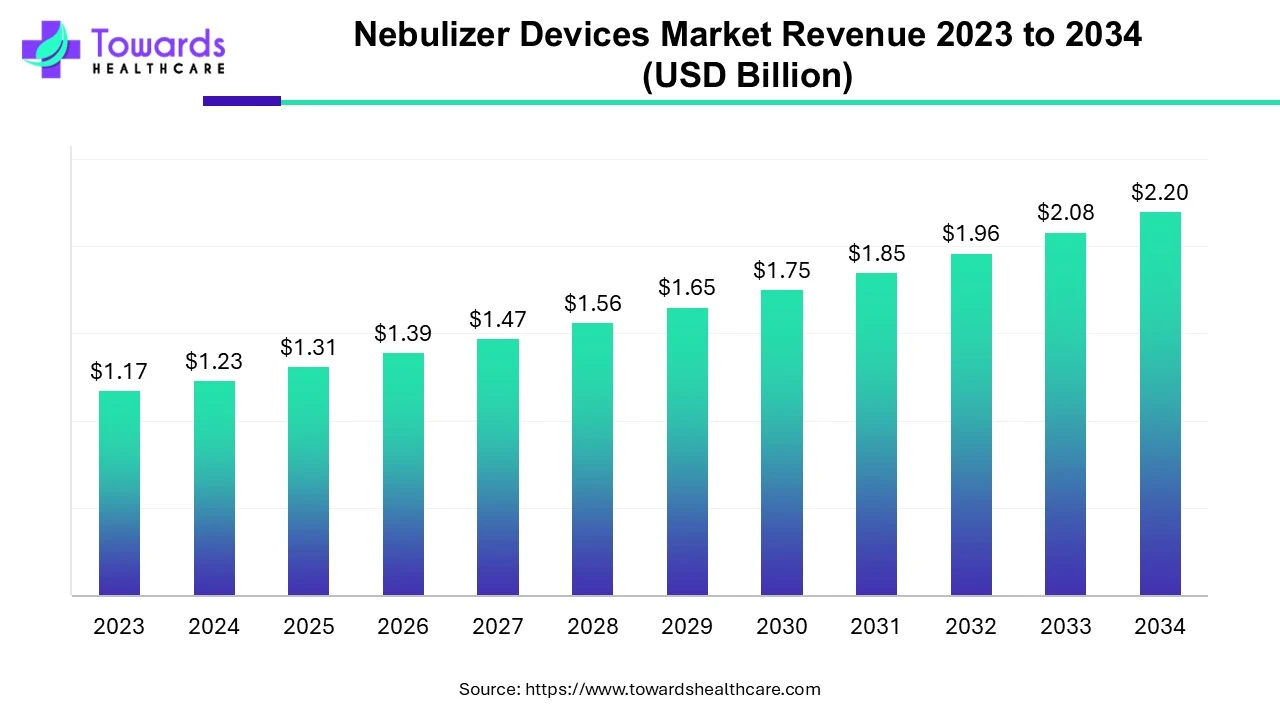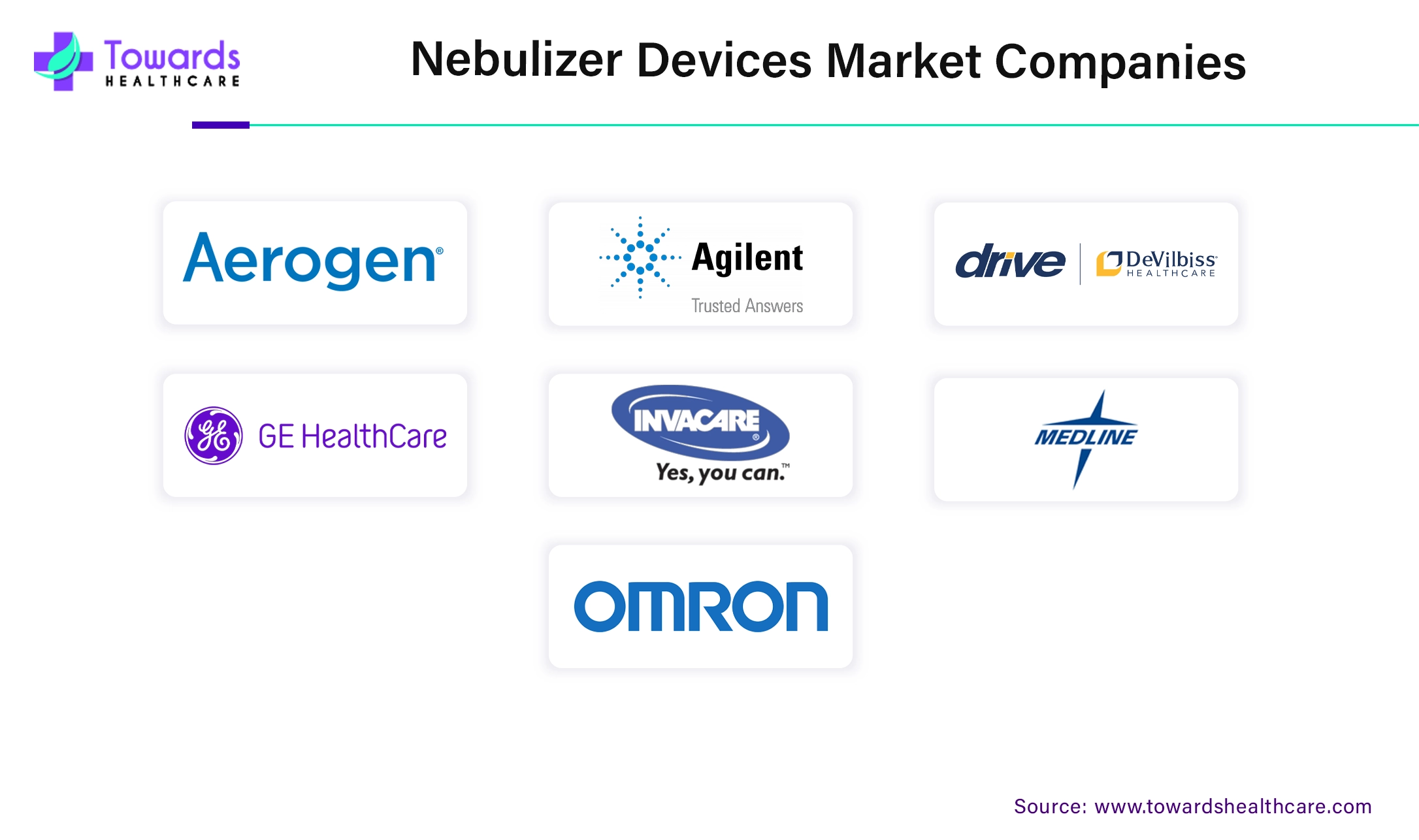April 2025

The nebulizer devices market size was estimated at US$ 1.17 billion in 2023 and is projected to grow to US$ 2.2 billion by 2034, rising at a compound annual growth rate (CAGR) of 5.94% from 2024 to 2034. The rising incidences of chronic respiratory disorders, advancements in medical devices, and increasing investments drive the market.

A nebulizer is a medical device that converts liquid medication into mist to deliver to the lungs directly through inhalation. It is commonly used in COPD, asthma, cystic fibrosis, bronchiectasis, and other respiratory conditions. Nebulizers come in home (tabletop) and portable models. Home nebulizers are larger and have to be plugged into an electrical outlet. In contrast, portable nebulizers run on batteries or can be plugged into a car outlet. There are three different types of nebulizers: jet, mesh, and ultrasonic. The medications that are used with a nebulizer are bronchodilators (to open the airways) and corticosteroids (to fight inflammation).
The rising incidences of chronic respiratory disorders increase the demand for nebulizers. It is estimated that COPD cases globally among those aged 25 years or above will increase by 23% from 2020 to 2050, accounting for 600 million cases. The growing research and development and increasing investments in the medical device sector boost the market.
The demand and use of nebulizers are increasing with the rising incidences of chronic respiratory disorders. The latest innovations in the medical sector can revolutionize respiratory drug delivery, fostering enhanced treatment and care. Several researchers are currently investigating novel technologies to deliver medications through a nebulizer. Some novel technologies include electro-hydrodynamic spray technology, condensation liquid aerosol technology, and inkjet technology. Research is ongoing to reduce the size of nebulizers, making them more efficient and increasing portability. The advent of advanced technologies like artificial intelligence can modernize nebulizers. Nebulizers with AI can monitor patient use and provide feedback to the patient and caregiver. AI can also control the amount of drugs inhaled by patients, resulting in less drug wastage.
The major challenge of the market is the high cost of the device. The average cost of the device is $50-$200, which is comparatively higher than an inhaler. This limits the affordability of many patients in low- and middle-income countries and of those without insurance. Another major challenge is the high risk of infection from unsterile chambers or tubings. The long-term use of nebulizers can cause serious infections in the lungs.
North America dominated the nebulizer devices market in 2023. The rising incidences and prevalence of chronic respiratory disorders, increasing investments & collaborations, favorable government policies, and advanced healthcare infrastructure drive the market. COPD affects approximately 11.7 million individuals annually in the US. According to the Asthma and Allergy Foundation of America, more than 27 million people in the US are living with asthma. It was found that asthma was more common in females (10.8%) than in males (6.5%). There were around 40,000 people with cystic fibrosis in the US and 4,445 people in Canada in 2022. This necessitates the use of nebulizers in the region.
Asia-Pacific is anticipated to grow with the highest CAGR in the nebulizer devices market during the studied years. The rising geriatric population, increasing incidences & collaborations, growing research and development activities, and expanding healthcare infrastructure drive the market. According to the Global Asthma Report, around 35 million people in India suffered from asthma in 2022. Japan's government issued new guidelines, “Health Japan 21,” in fiscal 2024 to reduce the death rate of COPD patients from 13.3 per 100,000 in 2021 to 10.0 per 100,000 by 2032. Similarly, the Indian and Chinese governments are also at the forefront of eradicating COPD cases through screening and management.
By type, the jet segment held a dominant presence in the nebulizer devices market in 2023. Jet nebulizers use compressed gas to convert liquid medication to mist. They are more effective in delivering drugs that cannot be delivered through pressurized metered-dose inhalers and dry powder inhalers. They are widely preferred because of their ease of use, delivery of a wide range of medications, and low cost.
The mesh segment is predicted to witness lucrative growth in the market over the forecast period. Mesh nebulizers use a micropump technology to create a fine mist of medication. They are more efficient than jet nebulizers and can provide higher drug doses to patients. Also, it is demonstrated that mesh nebulizers have 2-3 times higher lung deposition than jet nebulizers. The demand for higher dose administration and technological advancements augment the segment's growth.
By application, the COPD segment led the global nebulizer devices market in 2023. The rising incidences of COPD due to the increasing prevalence of smoking in LMICs and the aging population in high-income countries boost the segment growth. It is estimated that the global prevalence of COPD is 10.3% and around 3 million deaths annually. Nebulizers can directly transfer the drugs deep into the lungs when inhalers are not effective.
The asthma segment will gain a significant share of the market over the studied period. The rising prevalence of asthma due to increasing smoking and air pollution in LMICs drives the segment's growth. The advent of digital technology and telemedicine aids in the monitoring of patients with asthma.
By end-user, the hospitals & clinics segment accounted for a considerable share of the nebulizer devices market in 2023. Hospitals & clinics have favorable infrastructure to install nebulizers and sufficient capital investments. Additionally, favorable reimbursement policies and the increasing number of patients potentiate segment growth.
The home healthcare segment is projected to expand significantly in the market in the coming years. The rising geriatric population globally favors home healthcare devices. According to the WHO, 1 in 6 people globally will be 60 years and above by 2030. By 2050, the global geriatric population will double to 2.1 billion. The rising incidences of chronic respiratory disorders in the geriatric population increase the demand for home healthcare devices.

By Type
By Application
By End-User
By Region
April 2025
April 2025
March 2025
March 2025